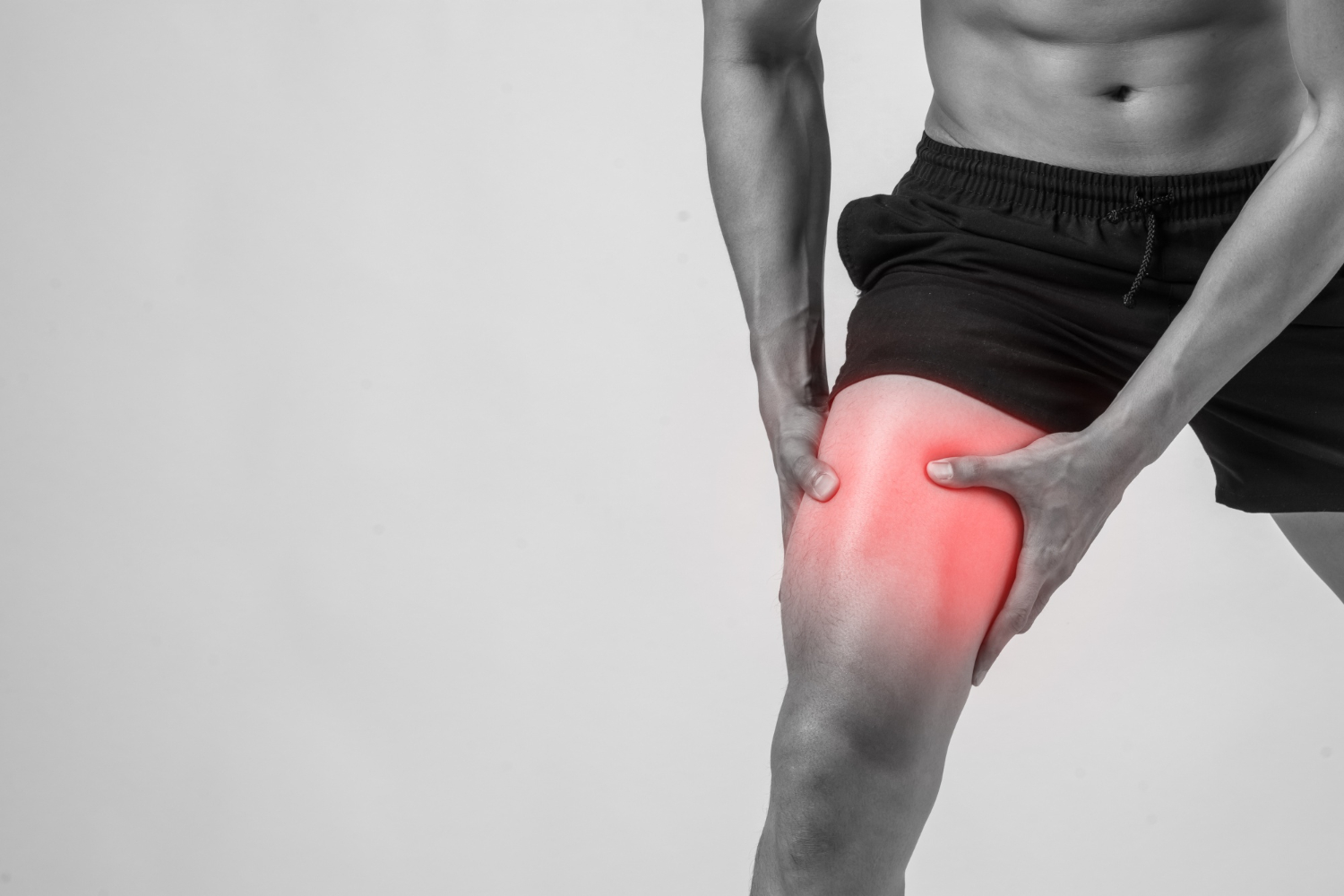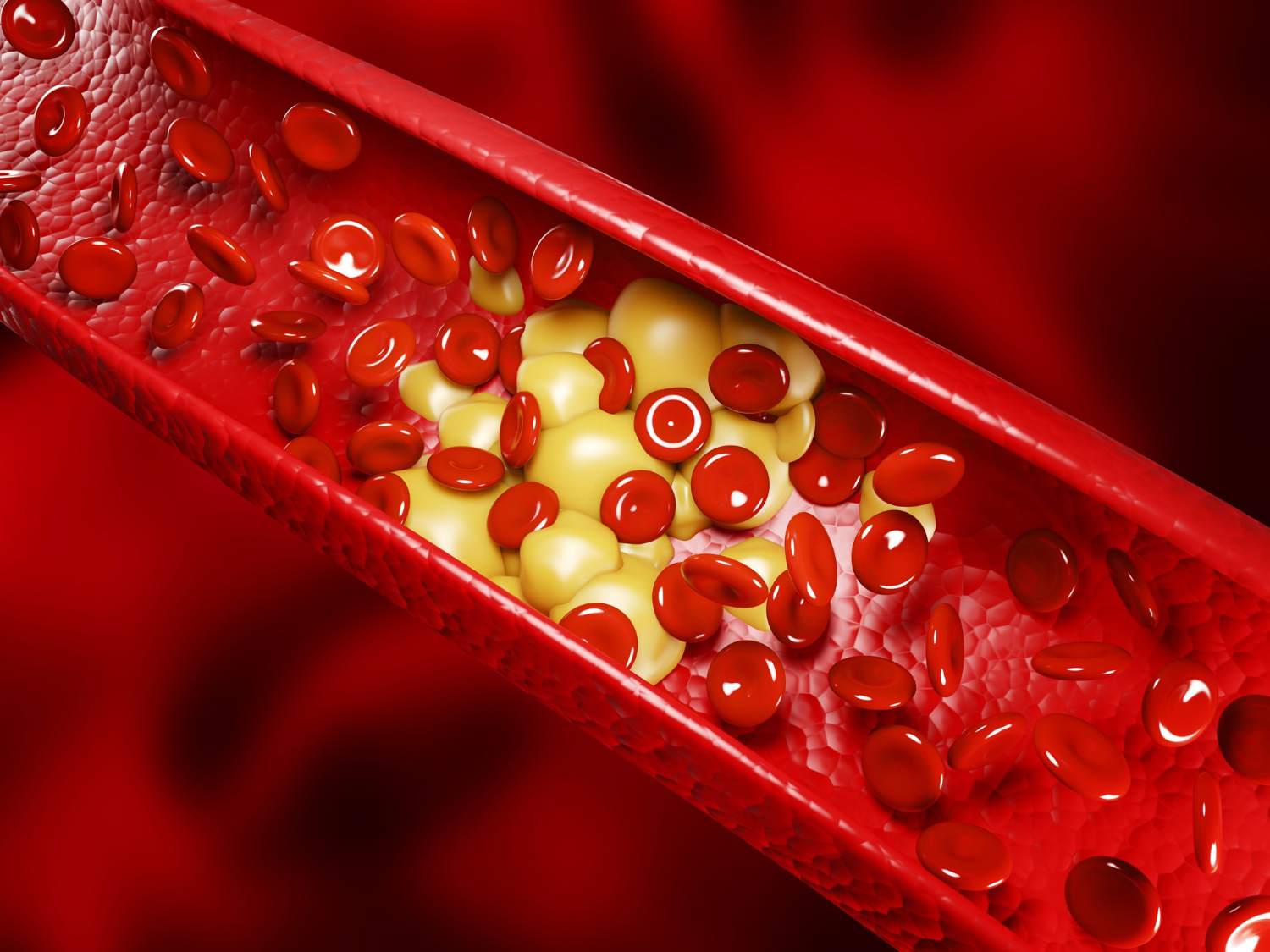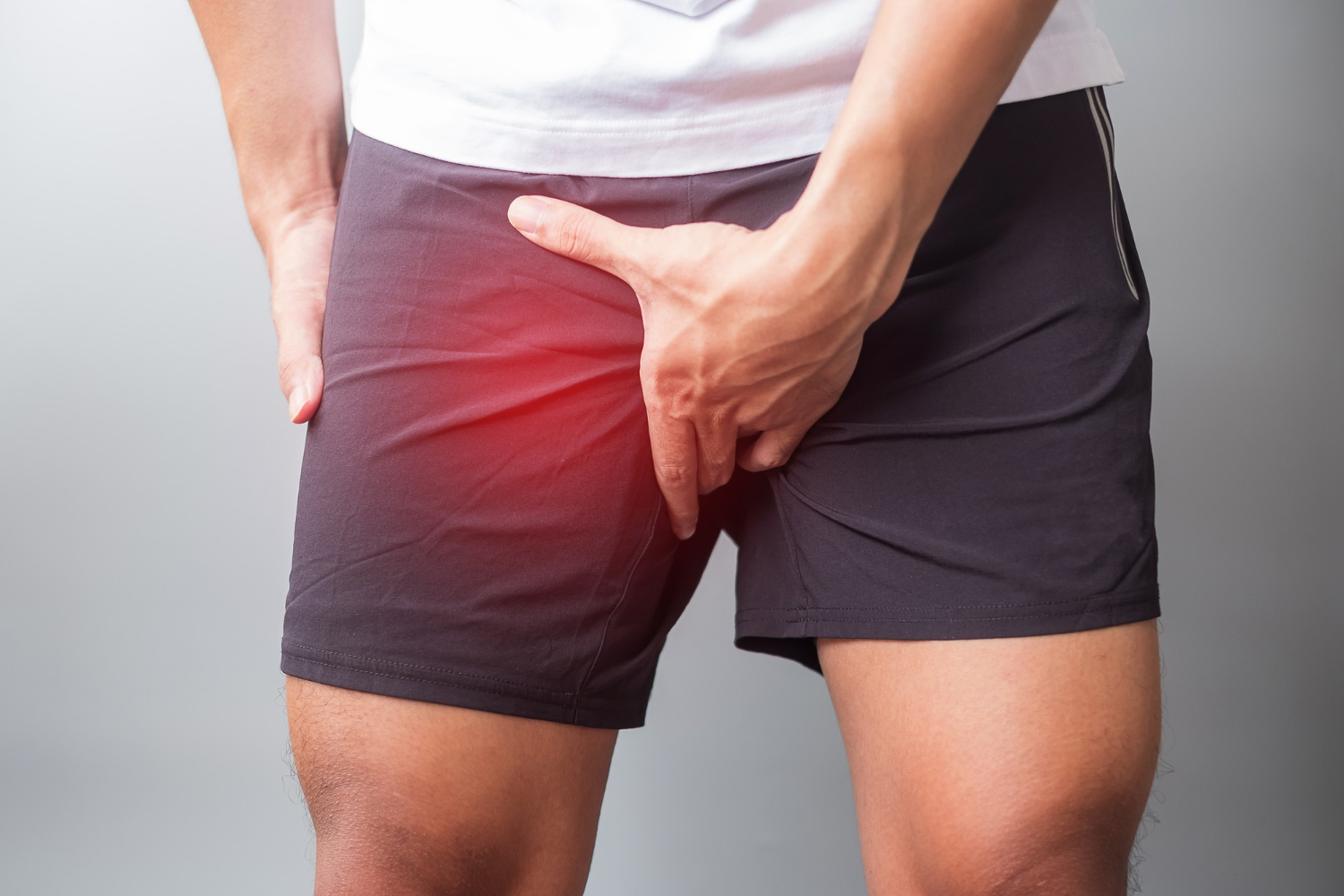Welcome to your extensive guide to understanding inner thigh pain.
As experts at Innovative Therapy PC, we’ve created this inner thigh pain guide to help you comprehend the root causes of thigh pain, understand its prevention and diagnosis, and explore treatments for relief.
Our goal is to provide a comprehensive resource that’s not only informative but also beneficial in managing and alleviating your discomfort.
Causes of Thigh Pain

Thigh pain, specifically in the inner area, can result from various factors.
Understanding these causes can aid in the swift resolution of the discomfort and prevent potential complications.
Pinched Spinal Nerve
A pinched spinal nerve, medically known as radiculopathy, arises when a nerve root in the spine is compressed, irritated, or inflamed.
This pressure can generate pain that radiates along the nerve’s path, potentially reaching the thigh region.
Radiculopathy can result from various conditions, including herniated discs, spinal stenosis, or bone spurs, which lead to spinal nerve compression.
Spinal Stenosis
Spinal stenosis is a health condition involving the narrowing of spaces within your spine, which can put pressure on the nerves traveling through the spinal column.
This narrowing can cause numerous symptoms, from pain and numbness to muscle weakness, which may radiate to the inner thigh.
Often seen in older adults, spinal stenosis typically results from wear-and-tear changes in the spine due to osteoarthritis.
Trauma
Physical trauma, such as that incurred in car accidents, falls, or sports injuries, can lead to inner thigh pain.
Trauma can lead to various injuries, including bone fractures, muscle strains, ligament sprains, or dislocation of joints.
Such injuries can lead to pain that’s immediate or delayed, based on the severity and location of the trauma.
Quadriceps or Hamstring Tendonitis
Tendonitis in the quadriceps or hamstring muscles is a common cause of thigh pain.
These large muscle groups play a crucial role in leg movement and support.
Inflammation in these tendons—often caused by excessive use, injury, or age-related wear and tear—can result in localized pain and discomfort in the inner thigh.
Symptoms may also include tenderness, swelling, and weakness in the affected muscle group.
Iliotibial Band Friction Syndrome
The iliotibial band is a thick, long tendon that extends from the pelvic bone to the shinbone.
It aids in knee extension and hip abduction.
When this band becomes tight or inflamed—a condition known as iliotibial band friction syndrome—it can cause pain on the outer side of the knee.
In severe cases, this pain can radiate to the thigh or hip area.
Blood Clot

Deep Vein Thrombosis (DVT) is a serious medical condition where a blood clot forms in a deep vein, usually in the lower leg or thigh.
These clots can limit blood flow, causing swelling and leg pain.
If a clot breaks free and travels to the lungs, it can cause a pulmonary embolism—an often fatal complication.
If you experience sudden, severe thigh pain alongside swelling, warmth, and discoloration, seek immediate medical attention.
Muscle Injuries
Inner thigh pain can result from muscle injuries such as strains, tears, or contusions in the adductor muscles—group of muscles located in the inner thigh that pull the legs together.
Such injuries usually occur due to sudden, forceful movements or long-term overuse, causing significant pain and potentially limiting movement.
Bone Conditions
Bone conditions like fractures, osteoporosis (a condition where bones become weak and brittle), or osteomyelitis (a rare but serious condition where a bone becomes infected) can cause severe thigh pain.
Fractures in the femur (thighbone) are particularly painful, while osteoporosis can make the bone susceptible to stress fractures.
Osteomyelitis often results from bacteria or fungi spreading through the bloodstream to the bone, causing intense pain.
Kidney Stones
Kidney stones are hard deposits made of minerals and salts that form inside your kidneys.
Although primarily causing lower back pain, kidney stones can occasionally lead to referred pain in the inner thigh or groin.
This referred pain happens when the stone moves down the ureter—the tube connecting the kidney to the bladder—and closer to the groin.
Pregnancy
Pregnancy can often bring about different forms of discomfort, including inner thigh pain.
As the body prepares for childbirth, it secretes a hormone called relaxin, which loosens the body’s ligaments and joints.
This, combined with a growing belly, can strain the inner thigh muscles, leading to pain.
Menstruation
Menstrual cycles can occasionally cause inner thigh pain.
This is often referred pain from the lower abdomen or back, resulting from uterine contractions during menstruation.
Hernia
A hernia occurs when an organ pushes through an opening in the muscle or tissue that holds it in place.
In particular, an inguinal hernia—when part of your intestine protrudes through a weak spot in the abdominal muscles—can cause inner thigh pain.
This pain typically worsens while coughing, lifting heavy objects, or bending over.
Prevention For Inner Thigh Pain

Preventing inner thigh pain fundamentally involves maintaining overall physical health.
This includes regular exercise, which strengthens your muscles, enhances flexibility, and ensures optimal blood flow—all crucial in reducing the risk of muscle strains and tears.
A balanced diet is equally important, providing your body with the necessary nutrients for muscle function and bone health.
Also, maintaining a healthy weight is essential, as excess weight can lead to increased stress on the muscles and joints, making them more prone to injury and pain.
Diagnosis of Thigh Pain
Understanding the cause of thigh pain involves a thorough physical examination and review of your medical history.
Healthcare providers will ask about your pain—its location, type, severity, and duration.
Additionally, they’ll consider your lifestyle factors, such as physical activity levels, dietary habits, and stress levels, which can all contribute to muscle strain and discomfort.
Diagnostic Tests For Thigh Pain
Your healthcare provider may order various diagnostic tests to better understand the cause of your thigh pain.
These could include X-rays, which visualize the bones to identify fractures or other abnormalities; CT scans or MRIs, which provide detailed images of muscles, ligaments, and tissues; and blood tests, which can reveal inflammation, infection, or other health conditions that may be causing your pain.
Treatment For Thigh Pain
Once diagnosed, treatment for inner thigh pain will depend on the cause and severity of your pain.
The primary aim is to alleviate pain, promote healing, and prevent further injury.
Exercise
Exercise is a vital part of both treatment and prevention for inner thigh pain.
Specific exercises and stretches can strengthen the thigh muscles, increase flexibility, and promote recovery.
However, it’s crucial to start slow and gradually increase your activity level to avoid exacerbating your pain or causing further injury.
Complementary and Alternative Medicine

In addition to conventional treatments, complementary therapies can play a significant role in managing inner thigh pain.
Always consult your healthcare provider before starting any new treatment.
Ice and Heat
Applying ice to the affected area can help reduce inflammation and numb the pain, especially in the first few days after an injury.
After this initial period, heat application can increase blood flow and promote healing.
These techniques can be used separately or alternately, depending on what provides the most relief.
Physical Therapy
Physical therapy can be beneficial for inner thigh pain, particularly when caused by muscular imbalances, injury, or postural issues.
A physical therapist will guide you through targeted exercises and stretches to improve your strength and flexibility, relieve pain, and prevent future injury.
Also Read:
My Hips Hurt! Causes Of Hip Pain & First Steps To Relieve Your Pain
Bursa of the Pelvis | Hip Bursitis Explained (Symptoms, Causes, Treatment)
FAQs About Inner Thigh Pain Guide
How do you relieve inner thigh pain?
Inner thigh pain relief can involve various methods depending on the underlying cause.
Over-the-counter pain medications, rest, ice and heat therapy, gentle stretches, and physical therapy are all potential treatments.
For severe or persistent pain, it’s essential to consult with a healthcare provider for an accurate diagnosis and treatment plan.
Can thigh pain be serious?
While thigh pain is often due to a minor injury or overuse, it can sometimes indicate a more serious health condition, such as deep vein thrombosis, bone infection, or certain types of cancer.
If you experience severe pain, swelling, redness, or warmth in your thigh, or if your pain is accompanied by other symptoms such as fever, unexplained weight loss, or persistent fatigue, seek medical attention immediately.
What does inner thigh pain feel like?
Inner thigh pain can present itself in various ways, from a dull ache to a sharp, severe pain.
It may be constant or intermittent, and it may be localized or radiate to other areas of the leg.
The nature of the pain can provide important clues about its cause.
What nerve is inner thigh pain?
Inner thigh pain can involve several nerves, but most commonly, it’s associated with the obturator nerve.
This nerve arises from the lumbar spine and provides sensation to the inner thigh.
Any irritation or impingement of this nerve can result in inner thigh pain.
What causes leg pain at night?
Nighttime leg pain can be caused by different conditions, including peripheral neuropathy, restless legs syndrome, muscle cramps, or circulatory issues.
If you regularly experience leg pain at night, it’s crucial to discuss these symptoms with your healthcare provider.
What causes inner thigh pain?
Various conditions can cause inner thigh pain, including muscle strains, nerve impingement, hip problems, and certain health conditions like kidney stones or hernias.
Diagnosing the exact cause requires a thorough medical examination and potentially further diagnostic tests.
Which muscles are in the front of the thighs?
The quadriceps femoris is a large muscle group located at the front of the thigh, comprising four individual muscles: the rectus femoris, vastus lateralis, vastus medialis, and vastus intermedius.
These muscles are crucial for walking, running, and jumping.
What causes numbness in the thighs?
Thigh numbness can be caused by conditions that affect the nerves supplying the thigh.
This can include nerve impingements, nerve damage (neuropathy), circulatory issues, and certain systemic diseases like diabetes.
What nerve causes pain in front of the thigh?
The femoral nerve, which originates in the lower spine and travels down the front of the thigh, can cause pain in the front of the thigh if it becomes compressed or damaged.
What causes pain in the upper inner thigh and groin?
Pain in the upper inner thigh and groin can be caused by a variety of conditions, including hip problems, nerve impingements, muscular strains, hernias, and certain health conditions like kidney stones or urinary tract infections.
What does sciatica leg pain feel like?
Sciatica leg pain usually presents as a sharp, shooting pain that travels down from the lower back, through the buttock, and down the back of one leg.
It’s caused by irritation or compression of the sciatic nerve.
Why do I have a burning sensation in my upper thigh?
A burning sensation in the upper thigh could be caused by meralgia paresthetica, a condition caused by compression of the lateral femoral cutaneous nerve.
It can also be a symptom of nerve damage or neuropathy, often associated with conditions like diabetes.
What causes upper thigh pain when walking?
Upper thigh pain when walking can be due to a variety of conditions, including muscle strain, nerve impingement, hip or knee joint problems, or vascular disease.
Identifying the exact cause requires a thorough medical evaluation.
Why do I have thigh pain at night?
Thigh pain at night could be due to conditions such as restless leg syndrome, peripheral neuropathy, or hip osteoarthritis.
It’s important to discuss this symptom with a healthcare provider to identify the underlying cause.
Can sciatica hurt in the front of the thigh?
Although sciatica typically causes pain in the back of the leg, it can occasionally cause pain in the front of the thigh.
This is usually due to the spread of disc material from a herniated disc, which can press on the femoral nerve.
Why do my legs ache when I lay down?
Leg pain when laying down can be due to circulatory problems, peripheral neuropathy, restless legs syndrome, or certain types of arthritis.
If you experience persistent or severe leg pain when lying down, it’s crucial to seek medical attention.
What could explain my inner thigh pain?
Several conditions could explain inner thigh pain, including muscular strains or tears, nerve impingement, joint problems, or certain health conditions like kidney stones or hernias.
A healthcare provider can help determine the cause of the pain through a comprehensive physical examination and possibly diagnostic tests.
Conclusion
Experiencing inner thigh pain can be challenging, but understanding its causes and treatment options can significantly aid your journey towards relief.
Remember, this guide is meant to be informative but not a replacement for professional medical consultation.
If you’re experiencing severe or persistent inner thigh pain, please reach out to a healthcare provider.
At Innovative Therapy PC, we’re dedicated to helping you regain your health and improve your quality of life.
Our team is ready to guide you through a personalized diagnosis and treatment process tailored to your specific needs.
Don’t let inner thigh pain control your life. Let’s work together towards your journey to a pain-free life.
Contact us at Innovative Therapy PC at (214) 225-8530 or email us at mary@innovativetherapypc.com to schedule your consultation.
Together, we can navigate the path towards pain relief and improved well-being.






5 Responses
Inner thigh pain can be a source of discomfort and limitation in your daily activities. It can stem from various causes, including muscle strains, overuse, or underlying medical conditions. This guide will help you understand the causes, prevention, diagnosis, and treatment options for inner thigh pain.
The pain and discomfort I’m experiencing is so intense it stops me in misstep and I can only squat until the pain subsides it’s been about 8 days I’m going to see a Provider on Monday can’t take it no more.
I’ve been suffering from inner thighs pain, well its more like a ache. I do have a hiatus hernia. I suffered with this a few years ago and it was down to the lack of B12 which I now have every 3 months. I’m on my feet all day. I’ve tried numerous of different remedies and nothing is working. The only thing that gets me through the day is wearing compression tights, which takes so long to put on. I really need zo get this sorted, please help me.